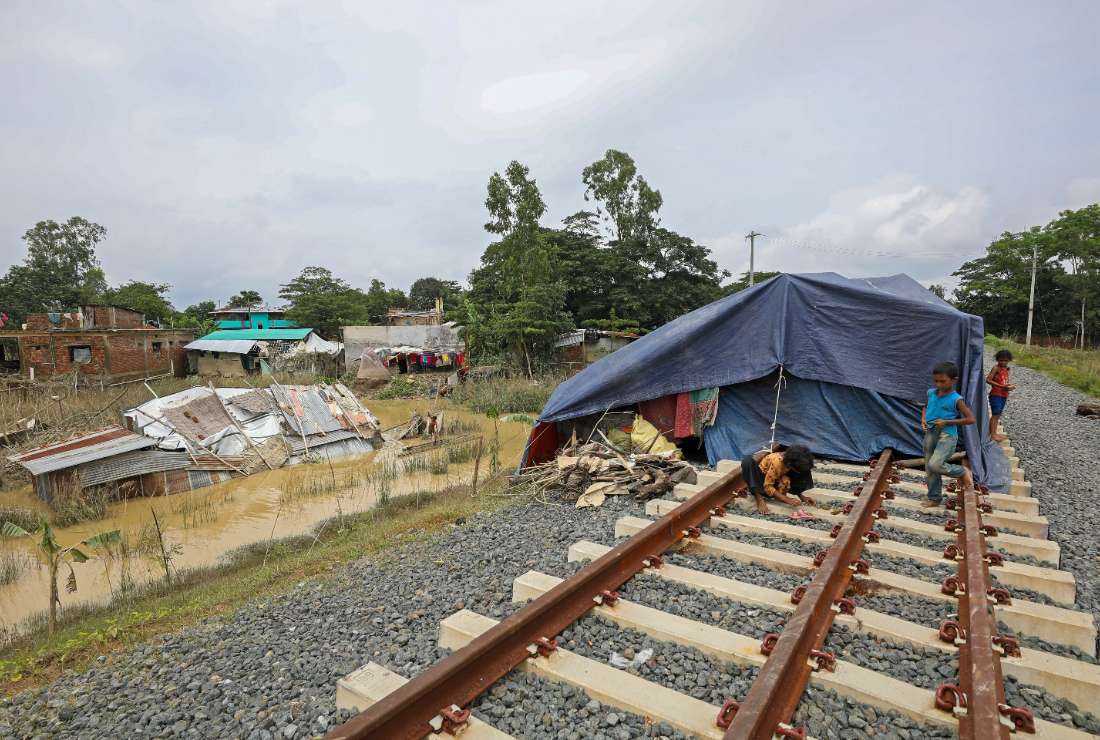
Flood-affected people take shelter on a railway track after heavy rains in Satkania on Aug. 13. At least 55 people have been killed and more than a million affected by two weeks of torrential rains causing floods and landslides in southeast Bangladesh, officials said. (Photo by AFP)
Thousands of families are reeling from a lack of aid after losing everything to devastating flash floods and landslides in southeastern Bangladesh, volunteers and aid workers say.
The flooding between Aug. 7-11 affected tens of thousands of people including ethnic minority groups in Chattogram division. The region is home to about 33 million people including an estimated one million indigenous people.
The districts of Chattogram, Bandarban and Cox’s Bazar were most affected, according to aid groups.
An official account of flood damages and losses is still not available.
Even with a robust government rehabilitation scheme, it will be hard and may take long for people to overcome their losses, aid workers say.
Chattogram division is home to about 60 percent of Bangladesh’s ethnic minority people in the Muslim-majority nation of more than 164 million.
Flash floods and landslides, triggered by heavy rains that started on Aug. 4 in Bangladesh and upstream India and Myanmar, left numerous ethnic minority villages and vast stretches of crop fields buried in thick layers of mud.
Many of these villages sit on the banks of hilly rivers such as the Matamuhuri and the Sangu, which swelled by up to six meters on Aug. 7 and 8, with the onrush of water from hilly terrains of India and Myanmar flowing through them for four days.
The Sangu flowed more than four meters above its danger level while the Matamuhuri was three meters above its flood level on Aug. 8, washing away everything along their paths.
“The flood came with so much force that it washed away long stretches of stone beds of railroads,” said Marcel Ratan Guda, regional director of Catholic charity Caritas Chattogram.
“The flash flood took away everything that came along its path – roads, houses and standing crops,” he said.
Guda said Caritas offered dry food to 600 families in government shelters that altogether housed about 50,000 evacuees.
Currently, the agency is in the process of offering cash aid and hygiene materials to 2,620 families.
Various national and international voluntary organizations have joined the government to offer relief to affected communities.
Flooding affected 40 percent of Chattogram division (out of 34,000 square kilometers), affecting over one million people and killing 54 in five districts, aid groups say. More than 50,000 hectares of cropland were damaged.
Hundreds of people are still living in polythene-made roadside tents for the flash flood wiped off parts of flood protection embankments along rivers, exposing many villages to tidal inundation, particularly in the coastal district of Cox’s Bazar.
In hilly-forested Bandarban, home to one million people, half of them ethnic minorities, about 60 percent area was inundated, triggering a series of landslides.
Caritas estimates that about 200,000 people from 60,000 households were affected as flooding hit 917 out of nearly 1,500 villagers in Bandarban.
Nearly 16,000 houses, some 14,000 toilets, and 1,300 tube wells were damaged in Bandarban, and 19,000 livestock and poultry were washed away.
Mong Pa, a volunteer of Desperately Seeking Bandarban, feared an outbreak of diseases amid a lack of clean water.
“We fear the outbreak of water-borne diseases such as diarrhea and skin diseases soon,” said Mong Pa.
“Water trucks are carrying water to people, but their number is not adequate while the water supplied looks unclean,” he added.
Mong Pa said he visited two villages on Aug. 13. Kalaghata village is home to 50 ethnic Tripura and Baum Christian families.
“All their belongings were damaged and buried in a mudslide,” he recalled.
Mong Pa said starvation is lurking for many families in remote areas who lost their crops and do not have any alternative land to grow crops again.
In Cox’s Bazar some 600 ethnic families have been affected by flooding, said Mong Than La, an indigenous rights activist from Bangladesh Adivasi Forum.
The affected people have not received any aid support yet, he said.
In Pekua, Cox’s Bazar, dozens of villages were submerged after the collapse of a flood protection embankment, forcing dozens of families to take shelter in temporary housing on the roads.
“Parts of our villages have literally become rivers,” said Safwanul Karim, a resident of Pekua.


